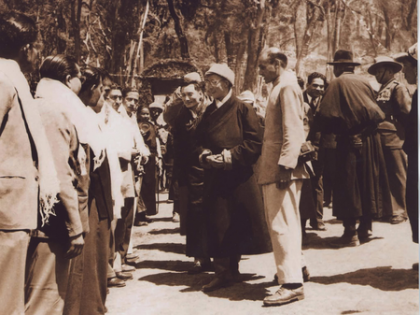The living Buddha's epic journey to save Tibet's identity
By IANS | Updated: June 30, 2025 13:43 IST2025-06-30T13:35:13+5:302025-06-30T13:43:55+5:30
Dharamsala, June 30 Sixty-six years ago, the 14th Dalai Lama, disguised as a soldier, left Norbulingka Palace in ...

The living Buddha's epic journey to save Tibet's identity
Dharamsala, June 30 Sixty-six years ago, the 14th Dalai Lama, disguised as a soldier, left Norbulingka Palace in Tibet, a Third Pole, and escaped into exile in India after his challenging 14-day journey.
Since then the longest most respectable staying guest of the Indian government, who often says he is enjoying every possible liberty, has been toeing a path of promoting human values, religious harmony, besides preserving Tibetan language and culture, the heritage received from the masters of India's Nalanda University.
Tenzin Gyatso, 14th Dalai Lama, with a retinue of soldiers and Cabinet Ministers escaped into exile on March 17, 1959, after China crushed an uprising in Tibet.
He is turning 90 on July 6.
Globetrotting the Dalai Lama, who is considered a living Buddha of compassion, in his latest book, 'In Voice for the Voiceless', offers insights into his decades-long dealings with China.
In the book the Dalai Lama, a reincarnation of past Dalai Lamas, reminds the world of Tibet's unresolved struggle for freedom and the hardship his people continue to face in their homeland.
The book captures his extraordinary life, uncovering what it means to lose your home to a repressive invader and build a life in exile; dealing with the existential crisis of a nation, its people, and its culture and religion; and envisioning the path forward.
He was 16-years-old when Communist China invaded Tibet in 1950, only 19 when he had his first meeting with Chairman Mao Zedong in Beijing, and 25 when he was forced to escape to India and became a leader in exile.
On reaching India after treacherous journey, the Dalai Lama first took up residence for about a year in Mussoorie in Uttarakhand.
On March 10, 1960, just before moving to Dharamsala, a town perched on the upper reaches of north India's Kangra Valley, the Dalai Lama had said: "For those of us in exile, I said that our priority must be resettlement and the continuity of our cultural traditions. We, Tibetans, would eventually prevail in regaining freedom for Tibet."
At present, India is home to around 100,000 Tibetans and the government-in-exile.
The Commandant of the Assam Rifles presented a guard of honour to the 14th Dalai Lama in Tawang on setting his foot on the Indian soil in 1959.
In an emotional reunion, the Dalai Lama in April 2017 met and embraced Havildar (retired) Naren Chandra Das of the Assam Rifles, the lone survivor of Indian personnel who were the first to receive him 58 years ago.
However, the Havildar passed away at the age of 83 in December 2021.
After arriving in India, the 14th Dalai Lama held his first press conference on June 20, 1959, in Mussoorie.
The Dalai Lama, whom Beijing regards as a dangerous "splittist", considers the Nobel peace laureate a dangerous separatist.
In a first, the Dalai Lama in May 2011 formally stepped down as head of the Tibetan government-in-exile, ending the 369-year old tradition of the Dalai Lamas holding dual responsibility of spiritual and temporal powers.
Subsequently, most of the administrative and political powers rest with the democratically-elected Prime Minister -- first by Lobsang Sangay for two consecutive terms and now by Penpa Tsering.
"I have now voluntarily brought this to an end, proud and satisfied that we can pursue the kind of democratic system of government flourishing elsewhere in the world," the Dalai Lama had said.
But the moot question now is -- Is Tibetan spiritual leader going to create another history of sorts by reversing the more than 600-year-old tradition of following the lineage of the Dalai Lama?
His followers believe the Dalai Lama is considering alternative scenarios.
One could be simply ending the system; another would see him leaving written instructions about the reincarnation process if an opinion did not favour its abolition.
Also, the Dalai Lama's followers firmly believe that before he dies his incarnation could be found, most probably in India, the birthplace of Buddhism.
All these probabilities will discussed threadbare at the three-day 15th Tibetan Religious Conference from July 2 in Dharamsala where Buddhist leaders, including heads and representatives of all four major schools of Tibetan Buddhism -- Gelug, Kagyu, Nyingma, and Sakya -- will meet.
The Dalai Lama will address the conference virtually on July 2.
"My reincarnation is to be decided by myself, nobody has the right to decide about that," the Dalai Lama, respected by millions as a living god, often said in his remarks.
Living in exile in India for more than six decades, the longing to see his homeland is still fresh in the mind of the Dalai Lama.
"Yes, I remain optimistic that I will be able to return to Tibet. China is in the process of changing," the Dalai Lama wrote on his website (dalailama.com).
He considers himself a son of India.
"All particles in my mind contain thoughts from Nalanda. And it's Indian 'dal' and 'chapati' that has built this body. I am mentally and physically a son of India," the Dalai Lama in his addresses is often quoted as saying.
"India and Tibet share a relationship of 'guru' (teacher) and 'chela' (disciple). When I see some part of my 'guru' being corrupt, as a 'chela' I feel ashamed."
Time and again, a demand from Indian Parliamentarians and his believers is being raised that India should confer its highest civilian award -- Bharat Ratna -- on him in recognition of his services to humanity.
The 14th Dalai Lama was born on July 6, 1935, in a small village in the remote Amdo region of Tibet.
Disclaimer: This post has been auto-published from an agency feed without any modifications to the text and has not been reviewed by an editor
Open in app